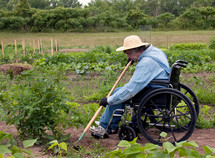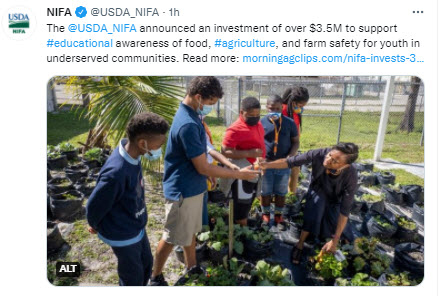|
Having trouble viewing this email? View it as a Web page.

|
|
|
Editor: Kelly Sprute November 10, 2021
Making a Difference
 Young white-tailed fawn, courtesy of Getty Images.
Study Finds Deer May Be Reservoir for SARS-CoV-2
More than 80 percent of the white-tailed deer sampled in different parts of Iowa between December 2020 and January 2021 tested positive for SARS-CoV-2. The percentage of SARS-CoV-2 positive deer increased throughout the study, with 33 percent of all deer testing positive. The findings suggest that white-tailed deer may be a reservoir for the virus to continually circulate and raise concerns of emergence of new strains that may prove a threat to wildlife and, possibly, to humans.
“This is the first direct evidence of SARS-CoV-2 virus in any free-living species, and our findings have important implications for the ecology and long-term persistence of the virus,” said Penn State University associate director for the Animal Diagnostic Laboratory Suresh Kuchipudi.
In this new study, the team examined nearly 300 samples collected from deer across the state of Iowa during the peak of human COVID-19 infection in 2020. Research supported by USDA’s National Institute of Food and Agriculture. For more information, read this Penn State article.
|
|

USDA Announces Scholars Programs for Students at Historically Black and Tribal Land-grant Colleges and Universities
The USDA today announced the Fiscal Year (FY) 2022 scholarship application cycle for the USDA 1890 National Scholars Program and the 1994 Tribal Scholars Program. These partnerships with the 19 1890 Land-grant Universities and 35 Tribal Colleges and Universities are among USDA’s efforts to develop the next generation of food and agriculture leaders and build an agriculture workforce that is more representative of America. These scholarship programs are administered through USDA’s Office of Partnerships and Public Engagement.
“The USDA 1890 National Scholars Program and the 1994 Tribal Scholars Program offer full scholarships that empower students at Minority-serving Institutions to pursue careers in agriculture,” said Dr. Lisa Ramirez, Director of USDA’s Office of Partnerships and Public Engagement. For more information, read the USDA press release.
|

NIFA Invests Nearly $7M for Tribal College Research and New Beginning for Tribal Students
NIFA announced today an investment of nearly $7 million for projects at Tribal Colleges and Institutions that support Tribal students and their communities. The Tribal College Research Grant Program helps colleges in the 1994 Land-grant University System become centers of scientific inquiry and learning for remote and rural reservation communities.
“This funding supports crucial, innovative research projects at Tribal-serving Colleges and Universities to address the specific needs of their communities,” said NIFA Director Dr. Carrie Castille. “The research projects focus on high-priority areas such as protecting reservation forests or monitoring water quality to promote sustainability and climate-smart agriculture and forestry on Tribal lands. Other projects aim to ensure food and nutrition security and support healthy Tribal populations through improving bison herd productivity, uncovering the ways traditional plants can impact diabetes, or controlling invasive species.” For more information, read this NIFA press release.
NIFA's investment supports innovative research projects at Tribal-serving Colleges and Universities to address specific needs of Tribal communities. Navajo student with laptop, courtesy Getty Images.
|

NIFA Invests in Research to Accommodate People with Disabilities Working in Agriculture
NIFA announced today an initial funding investment of more than $1.2M with a total investment of more than $5M over four years through USDA’s AgrAbility Program to help America’s farmers, ranchers and agricultural workers with disabilities remain productive and successful.
“For more than 30 years, the AgrAbility program has provided comprehensive support to producers with disabilities and their families to ensure they have access to the training, technologies and networks necessary to continue working in their chosen profession of agriculture,” said NIFA Director Dr. Carrie Castille. “To support the specialized needs of the AgrAbility community, the program builds service capacity at the state, regional and national levels through technical assistance, education and networking.” For more information, read the NIFA press release.
AgrAbility increases the likelihood that individuals with disabilities engaged in production agriculture can continue in their chosen profession. Photo by Getty Images.
|

Apply for USDA’s Equity Commission
USDA is requesting nominations for membership on the Equity Commission Advisory Committee and Equity Commission Subcommittee on Agriculture. “USDA is committed to advancing equity throughout our Department,” said Agriculture Secretary Tom Vilsack. “The Equity Commission is an important step in dismantling barriers historically underserved communities have faced in accessing USDA programs and services, especially with regard to access and inclusion in USDA agricultural programs and services.” To apply for the Equity Commission or the Sub-Committee on Agriculture, view the press release or the Federal Register Notice for more information and application instructions. For questions or additional information, contact equitycommission@usda.gov.
Diversity and Inclusion graphic, courtesy of Adobe Stock.
|

Growing Support for Innovations in Wood Products and Wood Energy
U.S. Forest Service resources support research and development of wood-based products, including grant programs now available for application. USDA’s Rod Bain talks with U.S. Forest Service’s Brian Brashaw on how wood is being used in new creative products and research. For more information, listen to this USDA broadcast.
Cross-laminated timber roof beams, courtesy of Adobe Stock.
|

A Big Plan for a Small Berry
University of Missouri’s Andrew Thomas, research assistant professor in the Division of Plant Science and Technology in the College of Agriculture, Food and Natural Resources, has big plans for a small berry. Thomas received a Specialty Crop Research Initiative grant from the USDA’s National Institute of Food and Agriculture for the project, “Moving American Elderberry into Mainstream Production and Processing.” Elderberry is a native plant found all over the Midwest and Eastern United States. Thomas, who has conducted elderberry research for 24 years, has found that the demand for elderberry products has increased over the last several years. For more information, read this University of Missouri CAFNR News article.
A cluster of ripe elderberries, courtesy of Getty Images.
|

Extension Financial Specialist Receives National Excellence in Extension Award
Whether you’re a high-schooler or an adult, you may have benefited from financial-literacy education programs developed by University of Tennessee’s (UT) Ann Allgood Berry, a professor with UT Extension Family and Consumer Sciences. Berry’s expertise in identifying financial education needs has been instrumental in delivering timely information to a vast number of Tennesseans over the years. As a result of her impactful work, Berry has received the 15th Annual Excellence in Extension Award from the Extension Committee on Organization and Policy. Presented by USDA’s National Institute of Food and Agriculture, Cooperative Extension, and the Association of Public Land-grant Universities. For more information, read this UT Institute News article.
Ann Allgood Berry, Courtesy of the University of Tennessee.
|

U of I Studies Free-Living Nitrogen Fixers in Organic Systems
Organic farmers often struggle to meet the nitrogen demands of corn and other crops. Unlike conventional farmers, with their easy access to inexpensive inorganic nitrogen fertilizers, fewer commercial options are available for organic growers. University of Illinois (U of I) researchers are exploring alternative approaches to improve soil nitrogen availability through free-living nitrogen-fixing bacteria. Their new $750,000 project is supported by the Agriculture and Food Research Initiative, part of the USDA's National Institute of Food and Agriculture. For more information, read this University of Illinois ACES news article.
The role of nutrients in plant life graphic, courtesy of Adobe Stock.
|

Intelligent Irrigation System: Increases Profits, Protects Environment
A team of Clemson University researchers is working to show how Intelligent Water and Nutrient Placement (IWNP) can help farmers increase profits while minimizing effects of agricultural practices on the environment. The team, led by irrigation specialist Jose Pavero, received a $453,405 grant from USDA’s National Institute of Food and Agriculture to develop technologies farmers can use to manage nutrients and water applied to crops through overhead irrigation systems. IWNP uses smart sensing and model-based decision support systems that can be readily adopted by farmers on both small and large scales making it easier and cost-effective for farmers to apply irrigation water and nutrients. For more information, read this Clemson University News article.
Field irrigation system, courtesy of Clemson University.
|

It’s Not Weird, It’s Nuts: Farmers Graze Cows in Groves of Trees
Farmers like Nelson Martin are turning away from the idea that cows must graze in open fields. He’s embracing an old practice that puts livestock and trees in the same space and he may help reduce pollution in the Chesapeake Bay and sequester carbon while he’s at it. With the help of the Chesapeake Bay Foundation and an Agriculture Department research grant, Martin’s planted dozens of apple trees and plans to venture into Chinese chestnut trees, too, transforming 20 or more acres into dual-purpose groves. Using grant money from USDA’s National Institute of Food and Agriculture, the foundation is working with five farms in south-central Pennsylvania to put trees on pastures, a practice called silvopasture. With about $80,000 in grant money, the nonprofit organization is taking three years to put in trees and begin to measure results. For more information, read this E&E Greenwire article.
Herd of cows grazing in a blooming orchard, courtesy of Getty Images.
|
Community Food Projects Competitive Grants Program
 Image of woman selling produce courtesy of Adobe Stock.
NIFA's Community Food Projects (CFP) funds two types of grants: Community Food Projects (CFP) and Planning Projects (PP). CFP supports the development of projects with a one-time infusion of federal dollars to make such projects self-sustaining. CFPs are designed to create community-based food projects with objectives, activities, and outcomes that are in alignment with Community Food Projects Competitive Grants Program (CFPCGP) primary goals. The purpose of a Planning Project (PP) is to complete a plan toward the improvement of community food security in keeping with the primary goals of the CFPCGP. Projects and plans are to focus on a defined community and describe in detail the activities and outcomes of the plan or project. For more information, read the CFP funding opportunity announcement.

|
|
|
NIFA’s mission is to invest in and advance agricultural research, education, and extension that solve societal challenges. NIFA’s investments in transformative science directly support the long-term prosperity and global preeminence of U.S. agriculture. Keep informed about NIFA, USDA, our land-grant and non-land-grant university partners, and stakeholders with the NIFA Update. Read past issues online, sign up for email updates or follow us on Twitter @USDA_NIFA, #NIFAImpacts or LinkedIn @usda-nifa.
If you wish to submit a news item or information, send an email to NIFAUpdate.
USDA is an equal opportunity lender, provider, and employer.
|
|
|
|